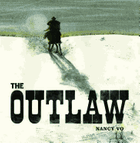
"Once there was an outlaw. Everyone knew of him by his trail of misdeeds." Train passengers would worry, "Will the Outlaw plunder this train?" Shopkeepers closed their stores early; children were warned to be good or "the Outlaw will get you!" And then, "one day," the Outlaw disappeared.
"Many seasons passed, until one hot windless day, a stranger rode into town." The "Old West"-style town "was a shadow of itself and in need of repair." The stranger sets to working. He builds a water trough for the inn, fixes the roof of the schoolhouse and starts building a train platform before someone recognizes him: "You. You are the Outlaw!" The angry townspeople spit at his feet and kick dirt at him; the Outlaw does nothing. A boy comes to the Outlaw's rescue, "Leave him alone! He's trying," and the crowd, some convinced, some not, slowly disperses. The Outlaw continues "to make amends." And maybe, the text tells us, that's what really matters "in the end."
Nancy Vo's debut picture book, The Outlaw, is a quiet, meticulously crafted work. The small trim size makes the book feel like a private treasure--something designed for small hands or the tight circle made by a child sitting on the lap of an adult reader. Vo's illustrations are monochromatic with occasional pops of muted blues, yellows and browns, creating gentle visuals to match the soft, sparse text. Even the materials used match Vo's subject matter and enhance the story: "The illustrations were done in ink, watercolor and newsprint transfer... using newspaper clippings and fabric patterns from the 1850s and 1860s. The title was produced with wood type on letterpress.... The text is set in Clarendon, commonly found on 'wanted' posters." This thoughtful story of redemption will likely spark deep conversations. --Siân Gaetano, children's and YA editor, Shelf Awareness

